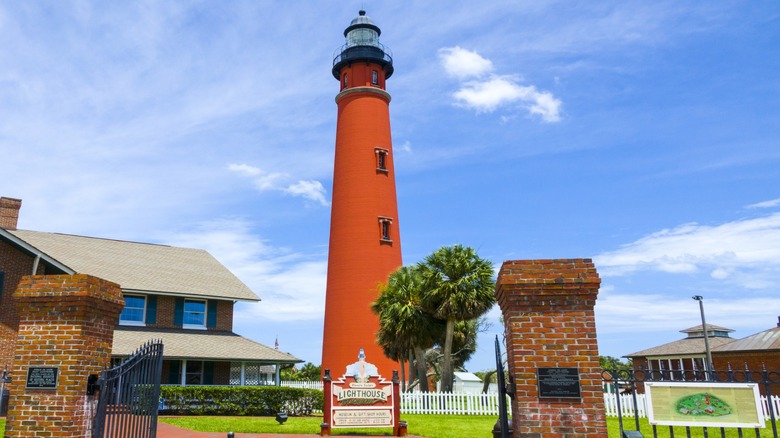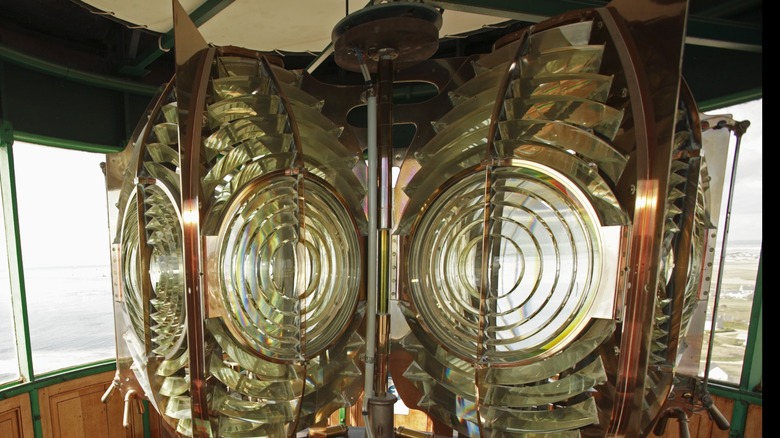Florida's Tallest Lighthouse Is A Giant Beacon Of History Offering The Most Scenic Coastal Views
If you like nautical iconography and are fascinated by the maritime marvels that are lighthouses, Florida's coastline, which is heavily dotted with lighthouses (like the Legacy Lighthouse with unmatched views of Miami Beach), is the place to go. However, if you are planning a vacation to Daytona, there's no better lighthouse to visit than the one at Ponce Inlet. The Ponce Inlet Lighthouse is the tallest lighthouse in Florida and is located on the Sunshine State's eastern shore, nestled between the Cape Canaveral Lighthouse and St. Augustine — America's oldest city full of family-friendly charm. Endeavoring to conquer the 203-step ascent to the top of the lighthouse takes you past a watch room and finally culminates at an overlook that provides a stunning view of the ocean and inlet that is well worth the effort. Mercifully, there are landings every 22 steps where visitors can stop and take a breather if necessary.
Know that gazing up at this red-brick tower is also to look up at a rich history, as the lighthouse illuminates part of Florida's colonial past. The original structure was built nearly 200 years ago in 1835 and became the target of a series of Seminole attacks during that same year. The last of these attacks saw the lighthouse stairs burned, after which a series of storms led to its eventual collapse. Yet the lighthouse hadn't seen the end of its days. Several ships were wrecked on its shores during its absence and a call to have the lighthouse rebuilt was answered in 1887. Today, the imposing structure stands well-preserved and overlooks New Smyrna Beach, a 17-mile stretch of roaring waves and white sand.
Step into the past at the Ponce Inlet Lighthouse and Museum
The Atlantic coast is full of seafaring stories of days past. Like the DiscoverSea Shipwreck Museum in Delaware that is filled with ocean wonders, artifacts, and maritime mysteries, the Ponce Inlet Lighthouse is an excellent place to explore this past. Named a National Historic Landmark in 1998, the lighthouse not only offers a unique look at Florida's past, but also an intimate peek at what life was like for the keepers who manned the structure, including a video of what life was like for a child living on the property. Restored versions of the families' quarters can be found on the grounds, along with a museum that houses lighthouse artifacts, including photographs dating back to the original structure, real antique furniture, and official uniforms.
At the museum, you can also learn fascinating tidbits about specific individuals associated with the lighthouse. For instance, it's curious why principal lighthouse keeper, William Rowlinski, couldn't get along with his assistant keepers. Furthermore, the first chief engineer was found mysteriously drowned on the shores of the inlet just as construction of the original lighthouse began in 1884. Aside from knowing how resilient the building is and the special knowledge that you are stepping into a structure that is nearly 150 years old, the lighthouse brings visitors into the past with a glance down at a few large cracks in the granite steps at the entrance. Old photographs indicate the cracks appeared during the Great Charleston Earthquake in 1886, which was so powerful effects could be felt as far away as Cuba.
Lighthouse technology is more intricate than you think
A visit to the Ponce Inlet Lighthouse and Museum can also take you back in time through technological advancements and marvels. Believe it or not, kerosene lamps were used to light the way for ships before the invention of the Fresnel Lens by Augustine-Jean Fresnel in 1822. The second construction of the Ponce Inlet Lighthouse was outfitted with these Fresnel Lens glass panels that magnify and intensify light beams and the original model can be seen on the ground floor of the building. The impressive, beehive-shaped 15-panel glass lens houses a surprisingly small lamp, making the fact that it can emit light visible 18 miles out to sea even more fascinating. The job of lighthouse keepers wasn't just to keep the lights on, but they also needed to time the beacon and keep a daily eye on weather conditions.
When visiting the Ponce Inlet Lighthouse, it's natural to want to capture these moments of history yourself, and luckily pictures and videos are allowed at the site — but drones are not. You are welcome to explore the grounds on your own but you might consider booking one of the lighthouse's special tours, such as its monthly "Climb to the Moon" tour where you can marvel at the gorgeous setting sun and subsequent full moon. Keep in mind that Florida commonly experiences thunderstorms during the summer, so be sure to check weather conditions before arriving.


